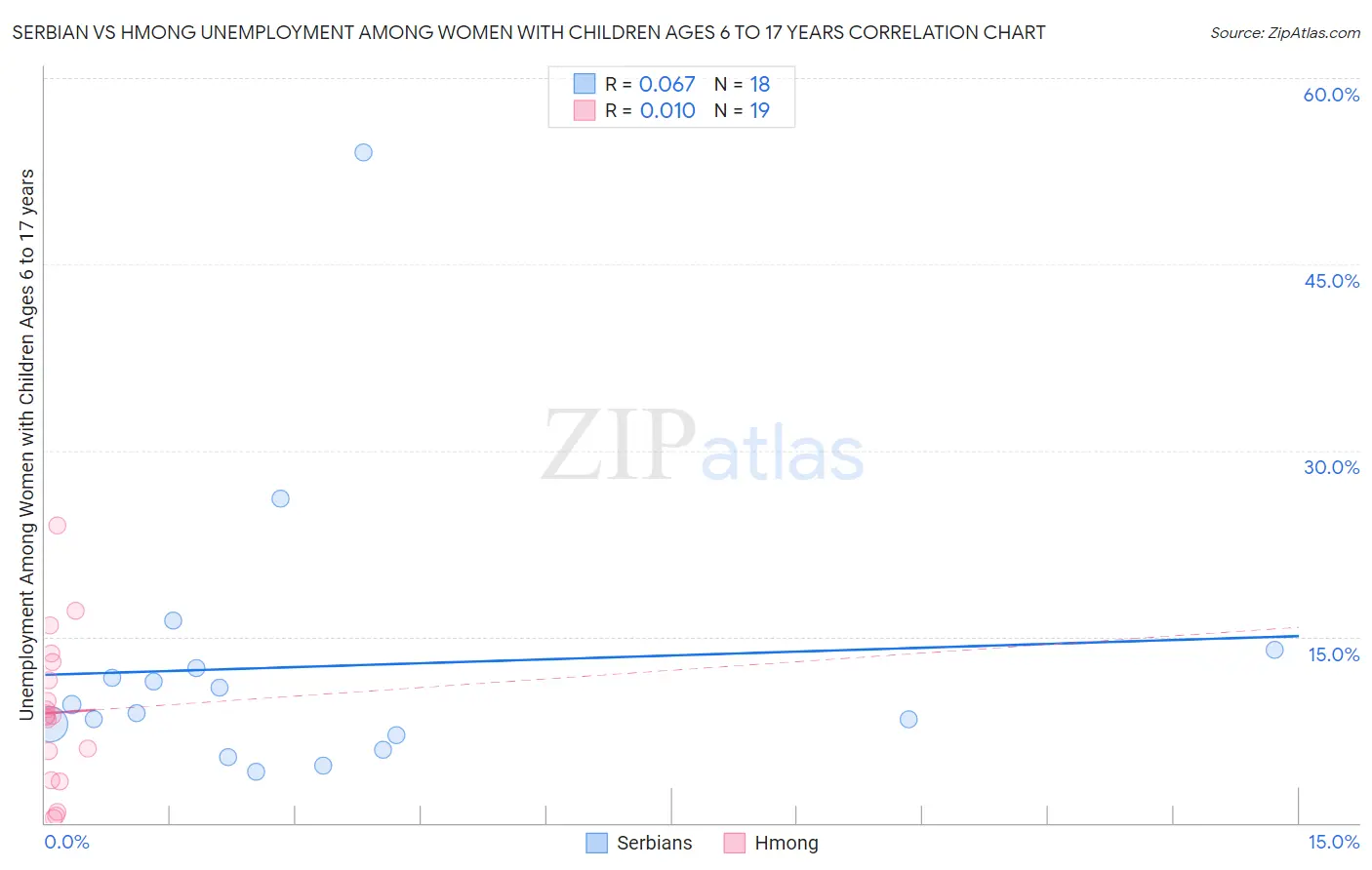Serbian vs Hmong Unemployment Among Women with Children Ages 6 to 17 years
COMPARE
Serbian
Hmong
Unemployment Among Women with Children Ages 6 to 17 years
Unemployment Among Women with Children Ages 6 to 17 years Comparison
Serbians
Hmong
8.8%
UNEMPLOYMENT AMONG WOMEN WITH CHILDREN AGES 6 TO 17 YEARS
87.6/ 100
METRIC RATING
141st/ 347
METRIC RANK
8.7%
UNEMPLOYMENT AMONG WOMEN WITH CHILDREN AGES 6 TO 17 YEARS
94.3/ 100
METRIC RATING
128th/ 347
METRIC RANK
Serbian vs Hmong Unemployment Among Women with Children Ages 6 to 17 years Correlation Chart
The statistical analysis conducted on geographies consisting of 199,468,329 people shows a slight positive correlation between the proportion of Serbians and unemployment rate among women with children between the ages 6 and 17 in the United States with a correlation coefficient (R) of 0.067 and weighted average of 8.8%. Similarly, the statistical analysis conducted on geographies consisting of 23,659,268 people shows no correlation between the proportion of Hmong and unemployment rate among women with children between the ages 6 and 17 in the United States with a correlation coefficient (R) of 0.010 and weighted average of 8.7%, a difference of 0.98%.

Unemployment Among Women with Children Ages 6 to 17 years Correlation Summary
| Measurement | Serbian | Hmong |
| Minimum | 4.2% | 0.40% |
| Maximum | 54.0% | 24.0% |
| Range | 49.8% | 23.6% |
| Mean | 12.6% | 8.9% |
| Median | 9.2% | 8.6% |
| Interquartile 25% (IQ1) | 7.1% | 3.4% |
| Interquartile 75% (IQ3) | 12.4% | 13.0% |
| Interquartile Range (IQR) | 5.3% | 9.6% |
| Standard Deviation (Sample) | 11.5% | 6.1% |
| Standard Deviation (Population) | 11.2% | 6.0% |
Demographics Similar to Serbians and Hmong by Unemployment Among Women with Children Ages 6 to 17 years
In terms of unemployment among women with children ages 6 to 17 years, the demographic groups most similar to Serbians are Immigrants from Austria (8.8%, a difference of 0.020%), Immigrants from Poland (8.8%, a difference of 0.070%), Immigrants from Kenya (8.8%, a difference of 0.15%), Northern European (8.8%, a difference of 0.18%), and Russian (8.8%, a difference of 0.18%). Similarly, the demographic groups most similar to Hmong are Czech (8.7%, a difference of 0.020%), Immigrants from Northern Africa (8.7%, a difference of 0.030%), South African (8.7%, a difference of 0.050%), Barbadian (8.7%, a difference of 0.10%), and Immigrants from Lebanon (8.7%, a difference of 0.12%).
| Demographics | Rating | Rank | Unemployment Among Women with Children Ages 6 to 17 years |
| Immigrants | Lebanon | 94.9 /100 | #124 | Exceptional 8.7% |
| South Africans | 94.6 /100 | #125 | Exceptional 8.7% |
| Immigrants | Northern Africa | 94.4 /100 | #126 | Exceptional 8.7% |
| Czechs | 94.4 /100 | #127 | Exceptional 8.7% |
| Hmong | 94.3 /100 | #128 | Exceptional 8.7% |
| Barbadians | 93.8 /100 | #129 | Exceptional 8.7% |
| Immigrants | Western Asia | 93.1 /100 | #130 | Exceptional 8.7% |
| Slavs | 92.2 /100 | #131 | Exceptional 8.7% |
| Yaqui | 92.2 /100 | #132 | Exceptional 8.7% |
| Egyptians | 91.8 /100 | #133 | Exceptional 8.7% |
| Immigrants | Ireland | 91.0 /100 | #134 | Exceptional 8.7% |
| Europeans | 90.6 /100 | #135 | Exceptional 8.7% |
| Immigrants | Latvia | 90.4 /100 | #136 | Exceptional 8.7% |
| Immigrants | Argentina | 90.0 /100 | #137 | Excellent 8.7% |
| Immigrants | Ethiopia | 89.5 /100 | #138 | Excellent 8.8% |
| Northern Europeans | 89.2 /100 | #139 | Excellent 8.8% |
| Immigrants | Poland | 88.3 /100 | #140 | Excellent 8.8% |
| Serbians | 87.6 /100 | #141 | Excellent 8.8% |
| Immigrants | Austria | 87.5 /100 | #142 | Excellent 8.8% |
| Immigrants | Kenya | 86.1 /100 | #143 | Excellent 8.8% |
| Russians | 85.8 /100 | #144 | Excellent 8.8% |